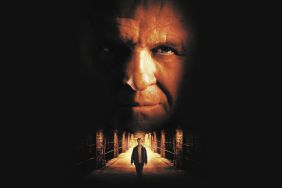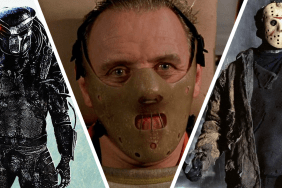
Have you ever seen blood in the moonlight, Will? It appears quite black.
In many ways, Manhunter feels more essential to Michael Manns filmography than any of his cops & robbers street operettas. The first cinematic adaptation of Red Dragon, Thomas Harris landmark slice of serial killer pulp, Mann morphs the horrific novel into a procedural focused on the art of detection and the duality of a trained demon hunter. Much how the director is completely transfixed by the blunt craft of the titular cat burglar in his big screen debut, Thief, Manns take on Harris tale of two maniacs revolves around not only the complex mechanisms of a detectives mind, but also the rigid primness of a mass murderers ritual. Where Vincent Hanna and Neil McCauley are flipsides to a moral coin in Heat, Will Graham (William Petersen) and Francis Dolarhyde (Tom Noonan) could easily swap stations in existence. Their only divide is the barrel of a gun, which Manns camera takes more than one opportunity to fetishize and stare down.
After Jonathan Demmes Silence of the Lambs won the Oscar for Best Picture, Ridley Scotts Hannibalreinvented the cannibalistic serial killer into a gothic Italian Dracula, and Peter Webbers Hannibal Rising seemingly killed the franchise off via crushing mediocrity (only to have Bryan Fullers pastiche-driven small screen freak-out revive it), one could easily forget that Michael Mann was the first to bring Hannibal Lecktor (not Lecter) into movie houses around the world. Red Dragon is the most visceral book in the Lecter series, brimming with a lurid voyeurism that never once flinches from the atrocities committed by its central predator, Francis The Tooth Fairy Dolarhyde (played here with chilling aloofness by Tom Noonan). And though Manns self-penned adaptation sticks fairly close to the 1981 bestsellers text, the style in which the story is brought to vivid life feels like an extension of the filmmakers iconic TV series, Miami Vice, which he had been shepherding as an Executive Producer for two years.
The results are something like a glam fever dream of sex, murder and tigers. Out of all of his hyper-stylized forays into the underbelly of humanity, Manhunterfeels like its ready to drown in Manns sea of neon rock n roll. While the white suits are still hanging down in Miami Beach, the writer/director isnt afraid to stick with his visual signatures. We first find Will Graham living in Florida, resting his tortured, FBI profiler mind by the sea — sandy Zen tableaus monitored with concern from a distance by his dutiful wife (Kim Griest). Once hes lured out of retirement by his former superior, Jack Crawford (Dennis Farina, whose Windy City twang is one of the few questionable casting decisions), Mann submerges us in darkness as Will navigates the frame, searching desperately for any clues regarding his preys whereabouts. The negative space of the early beach scenes disappears, replaced by a rigorous focus on filling the frame with information.
During these moments of intense, mechanical investigation, Manhunter begins Manns fascination with the demonstrative bodies in space style of performance direction which self-described vulgar auteurists fawn over. When Graham enters the blood-splattered post-modern Birmingham, Alabama home of Dolarhydes initial victims, Mann keeps the camera at a distance, letting the audience witness the detective interacting with his surroundings. Petersen does an outstanding job of narrating the events as he recreates them in his minds eye, selling the awkward adrenaline surge Graham feels from connecting with the heinous crime. So much of Manhunter hinges on Graham not only perusing the gloom of these steel and glass structures, but also the void his identification with these killers has created in his own soul. To simply call Petersens Graham haunted seems reductive. Heuristic feels more appropriate, as hes a man unafraid of touching the blackness he knows to be inherent in all human beings, whether they acknowledge its presence or not.

Mise-en-scène plays a huge role in how Manhunter communicates emotion from moment to moment. Mann keeps the audience at an arms length from both Graham and the killers he hunts. But the way he places Petersen in the frame allows us to become just as observant as he is when it comes to observing the trackers nature. At one point, Graham even looks into a window and sees his own face staring back at him. It’s just you and me now, sport, he says to his reflection, bluntly stating the duality weve come to recognize in the man. This is a hunter constantly teetering on the edge of joining those hes sworn to protect the public from. On the other side of sanity, the hair-lip Dolaryde is asking his victims if they can see his true form a writhing red monstrosity straight out of William Blakes paintings. Both men are harboring animalistic devils; only one uses his to try and catch the other.
Color plays a key part in communicating each particular scenes intense sensation. In Grahams home, whole rooms are bathed in blue, echoing the cooling security Will feels when hes with his wife and kids. In Dolarhydes world, a sickly green often infects the frame, lending each of his environments a death ward grunge. The purity of the blue contrasts with the putrid city; a place where Will can be infested by the evils of the world at any minute. By giving his lens over to Manns fully saturated color palette completely, cinematographer Dante Spinotti (who would go on to shoot both Heat and The Insider) creates a world both impressionistic and completely in line with the cultural aesthetic of a decade the director helped define. Combined with the movies somewhat diegetic use of music (The Power Movers Strong As I Am elevates a particularly garish moment of surreal violence), Mann harnesses the very essence of the motion picture at an almost ethereal level.
Manns intense devotion to authenticity led to Petersen working with the Violent Crimes Units of both the Chicago Police Department and the FBI in preparation for the role of Will Graham. He spoke with investigators on the case of serial rapist and murderer Richard Ramirez to try and learn how the officers compartmentalized the tragedies they witnessed every day.
Meanwhile, Mann researched with the FBIs Behavioral Science Unit in order to further try and understand the real life counterparts to Graham. And for several years, he corresponded with imprisoned murderer Dennis Wayne Wallace, who relayed an obsession he had with a woman to the director, going as far as to say that the two shared a song. That track was In-A-Gadda-Da-Via by Iron Butterfly, which Mann ended up including during the movies climactic shotgun battle.

Anthony Hopkins is the actor most associated with bon vivant man of murder Hannibal The Cannibal Lecter (though, with a few more seasons/tumblr posts, Mads Mikkelsen may very well surpass his popularity). But the initial casting of Hannibal Lecktor (as it is spelled in Harris novel) didnt even see Hopkins getting an audition for the role. John Lithgow, Mandy Patinkin, Brian Dennehy and even blustery writer/director William Friedkin (whose To Live and Die in LA helped land Petersen the Graham character) were all considered. However, it was Brian Cox, a Scottish actor with mostly UK screen acting credits, who ended up winning out over all. His Lecktor is significantly different from Hopkins Lecter, lacking the same bougie flair that has come to define the killer. Instead, Cox plays Lecktor like a boa constrictor in a zoos display; always eyeing the rats on the other side of the cage, knowing it could eat every single guest it honors alive. The expert character actor is an unsubtle delight, though Mann keeps Coxs scenes to a minimum. The filmmaker recognized that the character was such a charismatic horror that the audience should feel somewhat deprived when he isnt on screen, and thus uses him as an expertly placed shot of energy when the movie begins to lose steam.
The commercial influence of Manhunter is impossible to deny thirty years since its release. Before it, popular culture had cop shows but not ones that were such lapdogs to the actual procedure of detection. Everything from Criminal Minds to Bryan Fullers own inferior take on Will Graham owes its very existence to Michael Mann being so endlessly fascinated with how cops capture the deadliest members of our society. Hell, CSI straight up cast Petersen as the head investigator of a high tech forensic unit. The movies initial cult following blossomed into a full-on renaissance in the mainstream, never once crediting the director as its progenitor due to its initial commercial and critical failure. But Manhunter is simply another a signifier that Mann has always been two steps ahead of the commercial curve. Just like his later experimentation with digital would help push the medium into another realm of visual aesthetics, Mann was playing with the mold of the cop formula and reshaping it into something entirely new. As with all of his defining work, its an entertainment that never forgets its a piece of art, and vice versa.
—–
Jacob Knight is an Austin, Texas based film writer who moonlights as a clerk at Vulcan Video, one of the last great independent video stores in the US. You can find find him on Twitter @JacobQKnight.










